Not today – today has been rain all day. These are all from a few days back, and noticeably had the green thing going on, so…
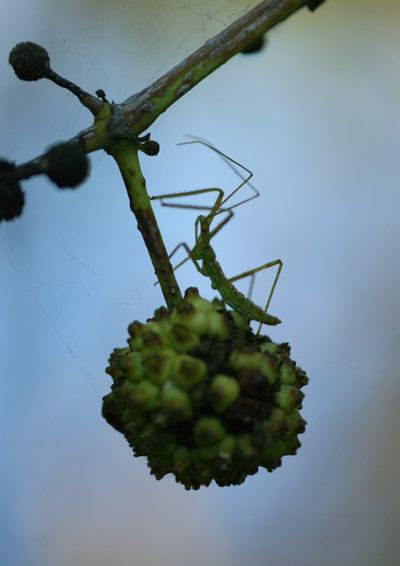 Over at the pond nearby, a pale green assassin (Zelus luridus) like the one seen a few posts back posed in shadow on the pod of a buttonbush (Cephalanthus occidentalis.) While I’ve been seeing them from the start of the insect season this year, for some reason I’ve been seeing more of them recently, and mostly in nymph form – this is telling me that their birthing period does not seem to be linked to seasons. My initial go-to source of arthropod info, BugGuide.net, has nothing to say about this. After shooting some natural light near-silhouettes with the pond in the background, wide open at f4, I added the extension tube for higher magnification – this requires a little fussing around, and while I was doing this, the assassin left the more photogenic location of the seed pod and started venturing up the branches. Thus, I had to abandon being fartsy and go for the basic illustration angle.
Over at the pond nearby, a pale green assassin (Zelus luridus) like the one seen a few posts back posed in shadow on the pod of a buttonbush (Cephalanthus occidentalis.) While I’ve been seeing them from the start of the insect season this year, for some reason I’ve been seeing more of them recently, and mostly in nymph form – this is telling me that their birthing period does not seem to be linked to seasons. My initial go-to source of arthropod info, BugGuide.net, has nothing to say about this. After shooting some natural light near-silhouettes with the pond in the background, wide open at f4, I added the extension tube for higher magnification – this requires a little fussing around, and while I was doing this, the assassin left the more photogenic location of the seed pod and started venturing up the branches. Thus, I had to abandon being fartsy and go for the basic illustration angle.
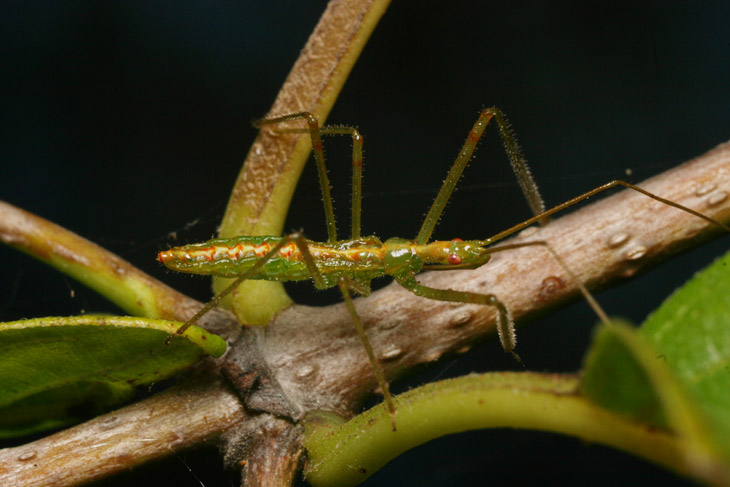
Now, while checking out the seasonal thing with the species, I found another interesting detail, not listed for the individual species but for the whole genus instead. See those fuzzy forelegs? Apparently, Zelus use a sticky substance that coats those tiny hairs to aid in capturing their food, using their forelegs sort of like a sundew plant. I’m going to have to do some serious closeups of them for a later post and see if I can illustrate this better. I have not witnessed them capturing any prey, and have only a few shots of them feeding at all, so now this is something to watch for.
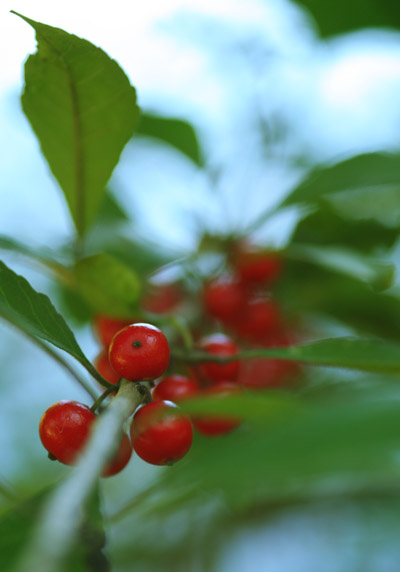 We’re going to gradually turn up the green as we go. In one spot alongside the pond, an unidentified tree was sporting tight clusters of berries, and like the first assassin image above, I picked an angle that would make use of the pond’s surface in the background – again, still working in shade since the light just wasn’t cooperating. An assassin in this composition might have been nice, but noooo, none of them could be found here. Try and make them famous, and this is what you get. Ingrates.
We’re going to gradually turn up the green as we go. In one spot alongside the pond, an unidentified tree was sporting tight clusters of berries, and like the first assassin image above, I picked an angle that would make use of the pond’s surface in the background – again, still working in shade since the light just wasn’t cooperating. An assassin in this composition might have been nice, but noooo, none of them could be found here. Try and make them famous, and this is what you get. Ingrates.

Not all insects were as uncooperative, though. A handsome meadow katydid (Orchelimum pulchellum) – ‘handsome’ is part of the name, not my editorializing – drew my attention by calling distinctly, and posed obligingly against the pond’s reflection of the sky. Disney’s Pinocchio informed us all wrong: no insects call or ‘sing’ by rubbing their hind legs together. Instead, orthopterans create their mating calls by vibrating rough areas of their wing sheaths against one another, sometimes seen as a blur along their mid-back area right between the hing legs. A lot of colorful things actually do better in softer light, getting bleached out by bright sunlight, but you have to admit it worked well for the hue of this species, and is a better version of the same approach seen here – same location, same plants, possibly even the same individual insect, but different lighting.
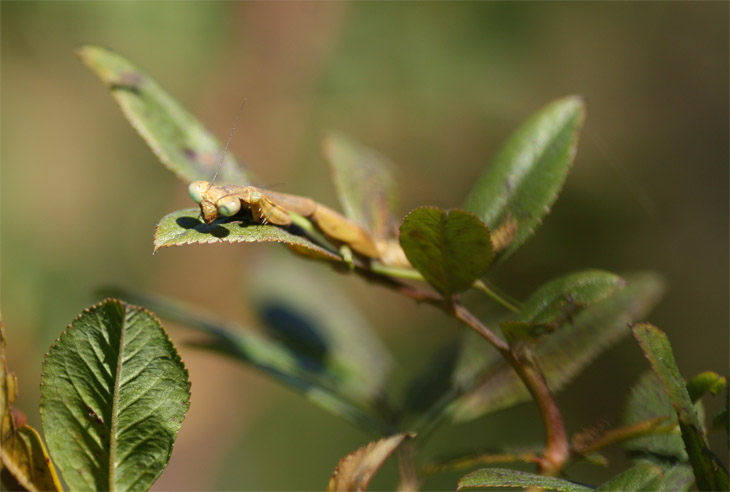
While in that immediate location, I found just one of the many Carolina mantids (Stagmomantis carolina) that I had been observing before, plastered down onto a leaf and looking rather unhappy. The nights have been getting cold, heralding the end of the insect season, and I was suspicious that the position indicated the mantis was dead, but it lifted its head and legs as I drew in close for the shots. However, my main purpose here is a distinctive illustration of one of the hazards of macro photography. The image above was shot at f4, but because the light was more than bright enough, I shot other frames at f11 and f16, realizing in doing so that there was something I was missing.
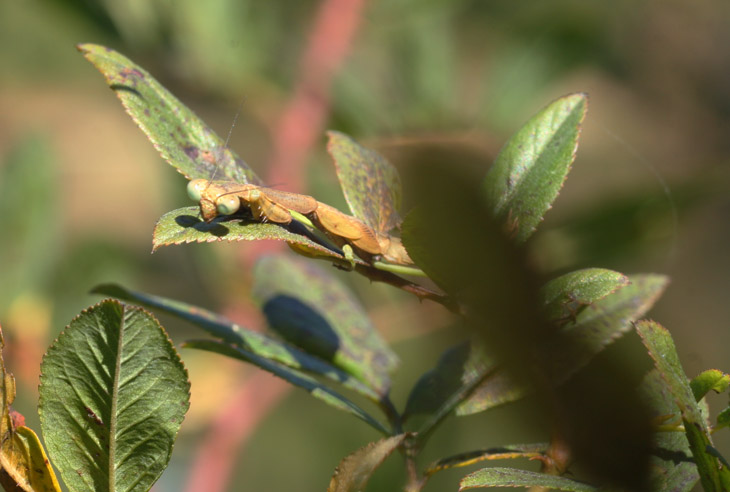
This is only a very slight change in perspective caused by inadvertently shifting a centimeter or two to the side, so the obscuring leaf isn’t something that I moved over to – it’s there in the top photo too, just so out-of-focus that it appears as a faint dark haze. When shooting macro through foliage and in tight conditions, it’s very easy to do this – you have a clear frame in the viewfinder and figure everything’s cool, until the aperture stops down upon releasing the shutter and you discover the foreground leaf later on. I was actually aware of this one quickly, since the Mamiya 80mm macro lens that I adapted to use on the Canon body requires the aperture to be closed manually and thus I could see it, unlike any automatic lens where the aperture only closes (no matter what the setting) when you trip the shutter. The difference is distinctive, isn’t it?
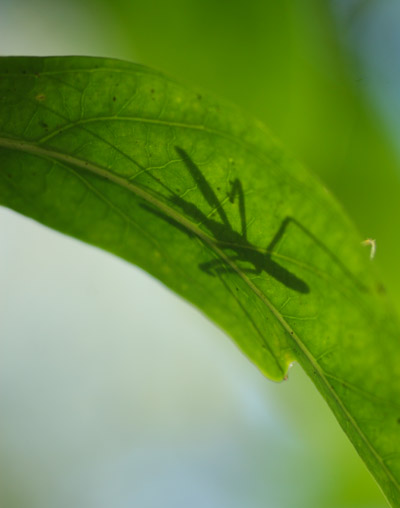 Back in the yard, I found yet another pale green assassin, this time on one of the gardenia bushes. I was just going to ignore it, but while searching for other species I noticed how sharp the shadow was when seen from the underside, and went back in to get the camera again – in the sporadic light of the backyard, I knew the sun could quickly move out of the position where the shadow could even be seen. Yes, that’s the tip of the hind leg peeking out over the leaf edge. I waited a bit to see if the assassin would give me a portrait shot over the edge as well, but like its brethren, it stubbornly moved away from a decent perspective.
Back in the yard, I found yet another pale green assassin, this time on one of the gardenia bushes. I was just going to ignore it, but while searching for other species I noticed how sharp the shadow was when seen from the underside, and went back in to get the camera again – in the sporadic light of the backyard, I knew the sun could quickly move out of the position where the shadow could even be seen. Yes, that’s the tip of the hind leg peeking out over the leaf edge. I waited a bit to see if the assassin would give me a portrait shot over the edge as well, but like its brethren, it stubbornly moved away from a decent perspective.
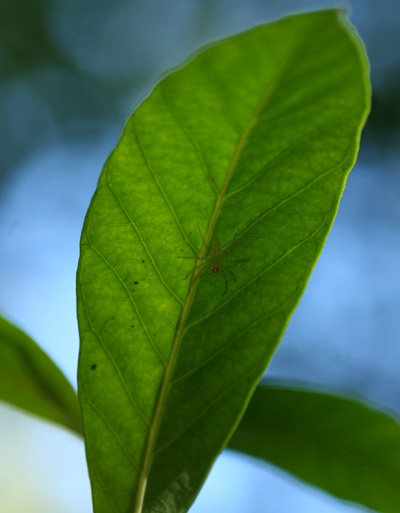 While down there however, I quickly spotted something on a neighboring leaf, this one partially shaded despite being not 20cm away. It was another of my old friends the magnolia green jumping spider (Lyssomanes viridis,) and the gardenia bushes seem far and away their favorite. Or at least, that I’ve managed to discover so far, because my experience now suggests that they typically inhabit the undersides of leaves, which is not a perspective I usually seek, so perhaps they like other plants better but I just haven’t been down there enough. Still, I’ve found four specimens on two bushes less than three meters apart, so the supporting evidence is there. And now I have an inkling of why this species, among so many other jumping spiders in the area, has such a translucent exoskeleton. From the underside of a leaf, coloration like that of the assassin bug isn’t enough to hide their presence, since the sun shining through will show them in silhouette. But with the transparency of the magnolia green jumper, largely all that shows is a few spots around their eyes and along their abdomen, doing a pretty good job of disguising their arachnoness. Arachnicity. C’mon, something has to get past spellcheck…
While down there however, I quickly spotted something on a neighboring leaf, this one partially shaded despite being not 20cm away. It was another of my old friends the magnolia green jumping spider (Lyssomanes viridis,) and the gardenia bushes seem far and away their favorite. Or at least, that I’ve managed to discover so far, because my experience now suggests that they typically inhabit the undersides of leaves, which is not a perspective I usually seek, so perhaps they like other plants better but I just haven’t been down there enough. Still, I’ve found four specimens on two bushes less than three meters apart, so the supporting evidence is there. And now I have an inkling of why this species, among so many other jumping spiders in the area, has such a translucent exoskeleton. From the underside of a leaf, coloration like that of the assassin bug isn’t enough to hide their presence, since the sun shining through will show them in silhouette. But with the transparency of the magnolia green jumper, largely all that shows is a few spots around their eyes and along their abdomen, doing a pretty good job of disguising their arachnoness. Arachnicity. C’mon, something has to get past spellcheck…
 The shot above was taken aiming almost straight up, so I sat back up and tried shooting nearly level, edgewise along the leaf, and the spider turned to face me suspiciously. This resulted in a series of images that I combined into an animated gif (pronounced “HEE-la“) – not half as good as the video linked above (or here for convenience,) but still illustrative. I was shooting without a tripod, so the images had to be matched up, and the wandering background perspective is evidence of my minor body movements as I shot the sequence – I’m never going to be able to do those fake statue hoaxes you see on YouTube. Still, it closes out the post nicely.
The shot above was taken aiming almost straight up, so I sat back up and tried shooting nearly level, edgewise along the leaf, and the spider turned to face me suspiciously. This resulted in a series of images that I combined into an animated gif (pronounced “HEE-la“) – not half as good as the video linked above (or here for convenience,) but still illustrative. I was shooting without a tripod, so the images had to be matched up, and the wandering background perspective is evidence of my minor body movements as I shot the sequence – I’m never going to be able to do those fake statue hoaxes you see on YouTube. Still, it closes out the post nicely.




















































